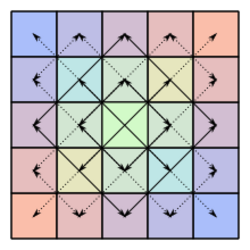Bisymmetric matrix
In mathematics, a bisymmetric matrix is a square matrix that is symmetric about both of its main diagonals. More precisely, an n × n matrix A is bisymmetric if it satisfies both A = AT (it is its own transpose), and AJ = JA, where J is the n × n exchange matrix.
For example, any matrix of the form
[math]\displaystyle{ \begin{bmatrix} a & b & c & d & e \\ b & f & g & h & d \\ c & g & i & g & c \\ d & h & g & f & b \\ e & d & c & b & a \end{bmatrix} = \begin{bmatrix} a_{11} & a_{12} & a_{13} & a_{14} & a_{15} \\ a_{12} & a_{22} & a_{23} & a_{24} & a_{14} \\ a_{13} & a_{23} & a_{33} & a_{23} & a_{13} \\ a_{14} & a_{24} & a_{23} & a_{22} & a_{12} \\ a_{15} & a_{14} & a_{13} & a_{12} & a_{11} \end{bmatrix} }[/math]
is bisymmetric. The associated [math]\displaystyle{ 5\times 5 }[/math] exchange matrix for this example is
[math]\displaystyle{ J_{5} = \begin{bmatrix} 0 & 0 & 0 & 0 & 1 \\ 0 & 0 & 0 & 1 & 0 \\ 0 & 0 & 1 & 0 & 0 \\ 0 & 1 & 0 & 0 & 0 \\ 1 & 0 & 0 & 0 & 0 \end{bmatrix} }[/math]
Properties
- Bisymmetric matrices are both symmetric centrosymmetric and symmetric persymmetric.
- The product of two bisymmetric matrices is a centrosymmetric matrix.
- Real-valued bisymmetric matrices are precisely those symmetric matrices whose eigenvalues remain the same aside from possible sign changes following pre- or post-multiplication by the exchange matrix.[1]
- If A is a real bisymmetric matrix with distinct eigenvalues, then the matrices that commute with A must be bisymmetric.[2]
- The inverse of bisymmetric matrices can be represented by recurrence formulas.[3]
References
- ↑ Tao, David; Yasuda, Mark (2002). "A spectral characterization of generalized real symmetric centrosymmetric and generalized real symmetric skew-centrosymmetric matrices". SIAM Journal on Matrix Analysis and Applications 23 (3): 885–895. doi:10.1137/S0895479801386730. https://zenodo.org/record/1236140.
- ↑ Yasuda, Mark (2012). "Some properties of commuting and anti-commuting m-involutions". Acta Mathematica Scientia 32 (2): 631–644. doi:10.1016/S0252-9602(12)60044-7.
- ↑ Wang, Yanfeng; Lü, Feng; Lü, Weiran (2018-01-10). "The inverse of bisymmetric matrices". Linear and Multilinear Algebra 67 (3): 479–489. doi:10.1080/03081087.2017.1422688. ISSN 0308-1087.
 |


